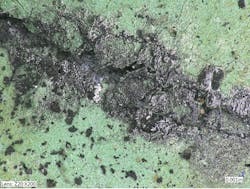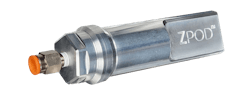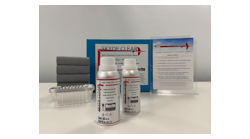Like any metal object, an aircraft is characteristically prone to corrosion. Much time is spent to delay it, but inevitably, nature will prevail. The development of decomposition depends on the age of the aircraft, what type of environment it is exposed to, how often it is cleaned and if it spends time in a hangar.
Simply put, corrosion is metal returning to its natural state. Corrosion is nothing more than rust of metal parts. However, aluminum does not produce the reddish color most think of as rust, rather, it first shows as a whitish dulling of the surface, then progresses to more severe pitting and eventual destruction of the metal.
Left untreated, deterioration can make an aircraft unairworthy in just a few years, so it is important to keep on top of preventative maintenance and if corrosion still appears, to get it under control quickly. Otherwise, you’ll be grounded — fast.
Manufacturer Recommendations
Anna Hayes, lead materials and processes (M&P) engineer for Piper says that since the issuance of CAR 3.296 back in the 40s, Piper has made the protection of structure a top priority. “The initial corrosion protection was the extensive use of Alclad, where a pure aluminum surface layer protected the underlying structural aluminum-copper alloy, which is otherwise susceptible to pitting corrosion,” she stated. “This evolved towards the use of zinc chromate primers that offered greater corrosion protection. Initially, the chromate primers were an option for ‘corrosion-proof’ enhancements and these became a standard for corrosion protection.” The issue with the zinc chromate corrosion inhibiting packages was that the hexavalent chemical state of chromium presented a hazard in that it could be readily absorbed into the body with adverse health effects, she notes.
Piper migrated away from high-concentrations of zinc chromate and started using a lower concentration of strontium chromate. Since then, significant technology advances have made corrosion protection and prevention safer, easier and more robust and the migration away from hexavalent chromium towards the stable, and nonhazardous, trivalent chromium with excellent results as evidenced by Piper testing with salt-fog testing.
Regardless of the technology, improper corrosion protection and ignoring routine preventative maintenance can singlehandedly cause a catastrophic failure. Hayes says one of the biggest ways to ensure you’re properly preventing corrosion on an aging aircraft is by keeping up-to-date with scheduled maintenance inspections, keeping the aircraft visibly clean and being attentive with any service bulletins (SB) and service letters (SL), as well as being mindful of advisory circular (AC) guidelines.
She shares that if you’d like to take it one step further than what’s required from the maintenance manual, SBs and SLs, Special Attention Inspections can be used for inspection in addition to the requirements. “The maintenance requirements and technology may have drastically changed since the aircraft was originally manufactured – especially when you’ve been producing aircraft for more than 80 years,” she explained. Information on special attention inspections can be found through the FAA’s Aging Aircraft Guide, which serves as an additional resource for corrosion guidance on aging aircraft.
How Often?
The frequency to which corrosion prevention should be completed depends on the inspection interval and what is due for inspection. Owners should refer to their maintenance manuals for interval inspection criteria. Every routine maintenance interval involves a visual inspection for corrosion – especially for flight-critical structures and hardware. “Keeping your aircraft visibly clean makes corrosion inspection easier,” Hayes offered. “Mechanics should be educated on the various forms of corrosion and inspect for any signs of rust, exfoliation, pitting, filiform, fretting corrosion, stress corrosion cracking, patina and aluminum oxides. Even the less obvious paint blisters, paint flakes and paint chips are all indicative of corrosion forming or a site for corrosion to form at a later date.”
In addition, it’s important to be mindful of the environment in which the aircraft is stored — corrosion propagation is highly influenced by environmental conditions. A material’s ability to withstand further propagation of corrosion can severely change with a minor change in the environment. For aircraft in regions with high salinity and high humidity, corrosion reacts quicker than aircrafts in regions with low salinity and low humidity. Aircraft maintenance manuals address inspection intervals for these areas. For the exterior of the structure, frequent washing and drying keeps contamination at bay and reduces the risk of corrosion.
Why Does it Happen?
Corrosion acts as a battery and requires an electrolyte, or a liquid path like water, to flow electrons — metallic substrate — from an active, anodic substrate, like aluminum, magnesium and zinc, and to a noble, cathodic substrate, like titanium, stainless steel, copper and chrome. The removal of one of these conditions will stop or prevent corrosion. “If we understand that having anodic and cathodic substrates may be part of design, it’s important for us to ensure that there’s an electrical barrier between these dissimilar metals and electrolytes are not present,” Hayes stated. “Paint is an effective treatment in that it can provides an electrical barrier, like wet installation of fasteners, and it acts as a water-impervious sealant for electrolyte barrier.”
The type of preventative maintenance depends on the part of the aircraft. Some typical preventative maintenance measures include removal of existing corrosion, creating barriers by the reapplication of lubrication and greases, reapplication of corrosion inhibiting compounds and touching up areas with missing primer or paint, as well as removing any “standing” water by ensuring all drainage holes remain free and clear of blockage, etc.
What to Do?
“Disconnect the theoretical battery,” Hayes said. Using the principles noted above to remove the ability for corrosion to form is the only method to prevent corrosion. If corrosion is present, it needs to be removed without compromising structural integrity. “Once the corrosion has been removed, the area needs to be thoroughly cleaned using an appropriate solvent or alkaline-based cleaner,” she noted. “Once the area has been thoroughly washed and dried, an application-specific barrier needs to be put in place such as a conversion coating, primer and paint, lubricant, grease or corrosion inhibitor.
New Aircraft
Hayes says with the issuance of AC 43-4 Corrosion Control of Aircrafts, there has been a huge movement in the aerospace industry to ensure robust corrosion protection within design. At Piper Aircraft, each design is carefully reviewed to ensure that an application-specific corrosion protection is specified. For example, during production, aluminum and carbon steel detail parts are protected from interim corrosion using lubricants and corrosion inhibitors, then either primed using an anticorrosive, chromated epoxy primer, conversion coated using a trivalent chromium conversion coating, aluminum only, phosphatized, steel only, then top coated — if applicable.
“The issue with the current corrosion inhibiting primer systems contain chromium (VI) trioxide, also commonly known as hexavalent chromium or CrVI. CrVI is a carcinogen which may increase the risk of cancer and can decompose into toxic hydrogen cyanide gas. It is extremely destructive to tissues in the respiratory tract. Recognizably, this compound is hazardous to workers who are handling the chemical and applying the corrosion inhibiting primer. It has been Piper’s mission to eliminate the usage of CrVI primers while still maintaining performance requirements.
Back in 2014, Piper’s Materials & Processes Engineering performed a baseline corrosion assessment of all Piper’s production primers and topcoats to ensure adequate corrosion protection of interior areas that are difficult to inspect. The scope of the project was to determine the expected life of primers and topcoats when put under extreme environmental stresses such as salt fogging per ASTM B117. The results would help provide a standard for performance that could later be used to find chromate-free primers.
As of May 2021, Piper has switched the exterior aircraft primer to a non-chromate alternative, Alumigrip 4101, a magnesium-rich primer. This is huge win for Piper’s initiative to be chrome-free for the health and safety of its employees and customers.
For newer aircraft, it is important to ensure that there is no missing primer or paint on the aircraft where there is intended to be primer or paint. If there’s any missing, touch up is required to keep that sacrificial layer intact. “Keeping up with inspection intervals and preventative maintenance will prolong the life of the aircraft and keep it operating safely,” explained Hayes. “Once corrosion appears, it’s paramount to keep it from propagating. Removing as much of the corrosion as possible while still maintaining structural integrity is key. After the corrosion has been removed, treating the area with an appropriate corrosion preventative is necessary to keep the corrosion from spreading."





